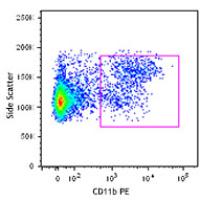-
Sign In
-

-
 Sony Biotechnology
Sony Biotechnology
-

-
 Sony Biotechnology
Sony Biotechnology
Mouse MDSC Flow Cocktail 1 with Isotype Ctrl
Cocktail
Sony
M1/70/RB6-8C5/1A8
Flow Cytometry
Rat IgG2a,Rat IgG2b
Mouse
25 tests
1335005
$358.00
Description
This mouse MDSC Flow Cocktail 1 is composed of CD11b, Gr-1, and Ly-6G antibodies and corresponding isotype controls. MDSCs have been reported with CD11b and Gr-1 phenotype. MDSCs are a heterogenous population of cells that can affect T cell function. Two different subsets of MDSC exist: CD11b+Ly-6G+Ly-6Clow (granulocytic MDSC) and CD11b+Ly-6G-Ly-6Chi (monocytic MDSC). These cells have been identified in a variety of pathological conditions including cancer and autoimmune disease.
CD11b: CD11b is a 170 kD glycoprotein also known as αM integrin, Mac-1 α subunit, Mol, CR3, and Ly-40. CD11b is a member of the integrin family, primarily expressed on granulocytes, monocytes/macrophages, dendritic cells, NK cells, and subsets of T and B cells. CD11b non-covalently associates with CD18 (β2 integrin) to form Mac-1. Mac-1 plays an important role in cell-cell interaction by binding its ligands ICAM-1 (CD54), ICAM-2 (CD102), ICAM-4 (CD242), iC3b, and fibrinogen.
Gr-1: Gr-1 is a 21-25 kD protein also known as Ly-6G/Ly-6C. This myeloid differentiation antigen is a glycosylphosphatidylinositol (GPI)-linked protein expressed on granulocytes and macrophages. In bone marrow, the expression levels of Gr-1 directly correlate with granulocyte differentiation and maturation; Gr-1 is also transiently expressed on bone marrow cells in the monocyte lineage. Immature Myeloid Gr-1+ cells play a role in the development of antitumor immunity.
Ly-6G: Lymphocyte antigen 6 complex, locus G (Ly-6G), a 21-25 kD GPI-anchored protein, is expressed on the majority of myeloid cells in bone marrow and peripheral granulocytes.
Formulation
Phosphate-buffered solution, pH 7.2, containing 0.09% sodium azide and 0.2% (w/v) BSA (origin USA).Recommended Usage
Each lot of these antibodies is quality control tested by immunofluorescent staining with flow cytometric analysis. For flow cytometric staining, the suggested use of this reagent is 20 microL per million cells or 20 microL per 100 microL of whole blood. It is recommended that the reagent be titrated for optimal performance for each application.


